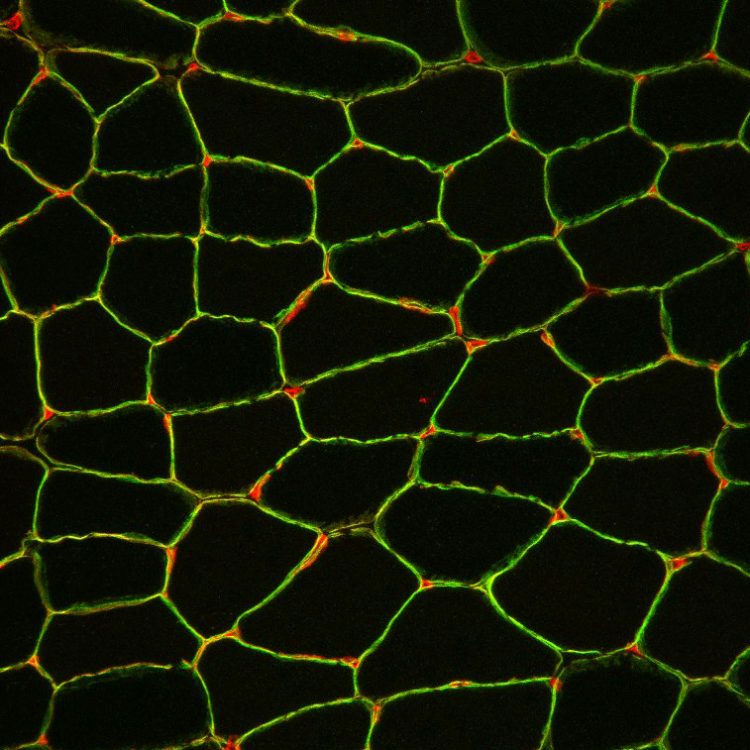Designed proteins to treat muscular dystrophy

Querschnitt einer Muskelbiopsie: Blutgefässe (rot) zwischen den Muskelfasern und Laminin-α2 (grün), welches jede Muskelfaser ummantelt. Universität Basel, Biozentrum
Muscular dystrophy is a term used to describe many different muscular diseases caused by genetic defects. To date, there are no treatments available to stop disease progression. In their study, the scientists led by Prof. Markus Rüegg have investigated a specific type of muscular dystrophy, called congenital muscular dystrophy.
In an animal model, they demonstrated for the first time that two proteins designed by the researchers not only recover muscle force and increase body weight in the sick animals but also significantly prolong survival.
Severe impairments due to congenital muscular dystrophy
Congenital muscular dystrophy is a rare and severe form of a muscular dystrophy that presents at birth or during infancy. “The children born with this disease are also called ′floppy infants′ because of the poor muscle tone and weakness,” says Judith Reinhard, first author of the study.
“The disease becomes more severe with increasing age, as the muscle wasting progresses.” Affected children are often unable to walk independently or they lose this ability with age. The respiratory muscles are also affected. The lifespan is often short and many patients die before reaching adulthood.
Defective gene – defective cell scaffolding
This form of muscular dystrophy results from a genetic defect in laminin-α2. This protein is a key component of the cell scaffolding and connects it with the inner part of the muscle fiber, ensuring the stability of the tissue. Consequently, as a result of gene defects in laminin-α2 the muscles are extremely unstable and even normal use of the muscles leads to muscle injuries, inflammation and finally to the degeneration of muscle fibers. In these diseased muscles, which are unable to produce laminin-α2, another laminin takes over. This protein, called laminin-α4, however, is only a poor replacement because it is not well integrated into the cell scaffolding.
Proteins anchor cell scaffolding and stabilize muscle fibers
The researchers designed two proteins that allow the integration of laminin-α4 and anchor it to the muscle cell. “Using these linkers, we were able to stabilize the muscle fibers,” explains Rüegg. “When animals with a laminin-α2 defect express the two linkers, there was a significant improvement in muscle structure and force and an increase in body weight. We were particularly pleased to observe that these animals also had an almost normal lifespan. Some of them even survived their healthy siblings.” Furthermore, the scientists examined muscle biopsies of patients with congenital muscular dystrophy. They found very similar structural defects and laminin-α4 was also found in place of laminin-α2 in the diseased muscle fibers.
“Both of the designed linker proteins may possibly be used in the future as a gene therapy treatment for congenital muscular dystrophy,” says Rüegg. “Our study is a nice example of how the understanding of a disease on the molecular and cellular level results in new therapeutic options. We are now interested in whether these linker proteins also improve muscle function as well as affect survival in advanced stages of congenital muscular dystrophy.”
Original article
Judith R. Reinhard, Shuo Lin, Karen K. McKee, Sarina Meinen, Stephanie C. Crosson, Maurizio Sury, Samantha Hobbs, Geraldine Maier, Peter D. Yurchenco and Markus A. Rüegg.
Linker proteins restore basement membrane and correct LAMA2-related muscular dystrophy in mice.
Science Translational Medicine, published online 28 June 2017
Further information
Markus Rüegg, University of Basel, Biozentrum, Tel. +41 61 207 22 23, email: markus-a.ruegg@unibas.ch
Media Contact
More Information:
http://www.unibas.chAll latest news from the category: Life Sciences and Chemistry
Articles and reports from the Life Sciences and chemistry area deal with applied and basic research into modern biology, chemistry and human medicine.
Valuable information can be found on a range of life sciences fields including bacteriology, biochemistry, bionics, bioinformatics, biophysics, biotechnology, genetics, geobotany, human biology, marine biology, microbiology, molecular biology, cellular biology, zoology, bioinorganic chemistry, microchemistry and environmental chemistry.
Newest articles

A ‘language’ for ML models to predict nanopore properties
A large number of 2D materials like graphene can have nanopores – small holes formed by missing atoms through which foreign substances can pass. The properties of these nanopores dictate many…

Clinically validated, wearable ultrasound patch
… for continuous blood pressure monitoring. A team of researchers at the University of California San Diego has developed a new and improved wearable ultrasound patch for continuous and noninvasive…

A new puzzle piece for string theory research
Dr. Ksenia Fedosova from the Cluster of Excellence Mathematics Münster, along with an international research team, has proven a conjecture in string theory that physicists had proposed regarding certain equations….



